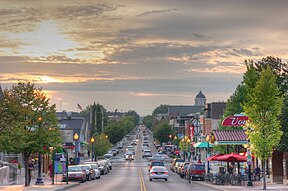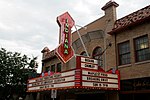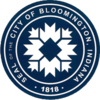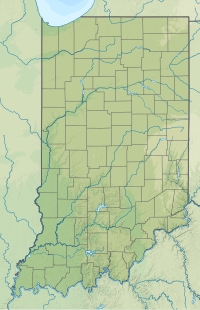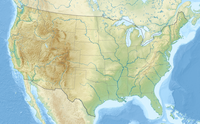Bloomington is a city in and the county seat of Monroe County, Indiana, United States.[3] The population was 79,168 at the 2020 census.[4] It is the seventh-most populous city in Indiana and the fourth-most populous outside the Indianapolis metropolitan area. It is the home of Indiana University Bloomington, the flagship campus of the Indiana University system. Established in 1820, IU Bloomington enrolls over 45,000 students.[5]
Bloomington | |
|---|---|
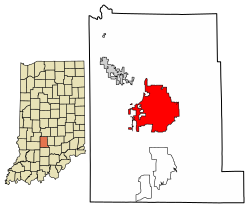 Location of Bloomington in Monroe County, Indiana | |
| Coordinates: 39°09′44″N 86°31′20″W / 39.16222°N 86.52222°W | |
| Country | United States |
| State | Indiana |
| County | Monroe |
| Townships | Bloomington, Perry, Richland, Van Buren |
| Government | |
| • Type | Mayor–council government |
| • Mayor | Kerry Thomson (D) |
| Area | |
• City | 23.43 sq mi (60.69 km2) |
| • Land | 23.25 sq mi (60.22 km2) |
| • Water | 0.18 sq mi (0.48 km2) |
| Elevation | 804 ft (245 m) |
| Population (2020) | |
• City | 79,168 |
| • Density | 3,405.08/sq mi (1,314.72/km2) |
| • Metro | 175,506 |
| Time zone | UTC−5 (EST) |
| • Summer (DST) | UTC−4 (EDT) |
| ZIP Codes | 47401–47408 |
| Area code | 812 & 930 |
| FIPS code | 18-05860 |
| GNIS ID | 2394196[2] |
| Website | www |
The city was established in 1818 by a group of settlers from Kentucky, Tennessee, the Carolinas, and Virginia who were so impressed with "a haven of blooms" that they called it Bloomington.[6] It is the principal city of the Bloomington metropolitan area in south-central Indiana, which had 161,039 residents in 2020. Bloomington has been designated a Tree City USA since 1984.[7][8] The city was also the location of the Academy Award–winning 1979 movie Breaking Away, featuring a reenactment of Indiana University's annual Little 500 bicycle race.
History
editThe area in which Bloomington is situated was previously inhabited by the Delaware, Potawatomi, Miami, and Eel River Miami.[9]
Bloomington was platted in 1818.[10] A post office has been in operation at Bloomington since 1825.[11] Bloomington was incorporated in 1827.[12]
The current city logo was adopted on January 6, 1986, by the Bloomington Common Council.[13] It was a combination of peony and trout lily, inspired by both quilt patterns used by regional folk artists in 19th century and the shape of Downtown Square.[13]
The Elias Abel House, Blair-Dunning House, Bloomington City Hall, Bloomington West Side Historic District, Cantol Wax Company Building, Coca-Cola Bottling Plant, Cochran-Helton-Lindley House, Courthouse Square Historic District, Hinkle-Garton Farmstead, Home Laundry Company, Illinois Central Railroad Freight Depot, Johnson's Creamery, Legg House, Millen House, Millen-Chase-McCalla House, Monroe Carnegie Library, Monroe County Courthouse, Morgan House, J.L. Nichols House and Studio, North Washington Street Historic District, The Old Crescent, Princess Theatre, Prospect Hill Historic District, Second Baptist Church, Seminary Square Park, Steele Dunning Historic District, University Courts Historic District, Vinegar Hill Historic District, Wicks Building, Woolery Stone Company, and Andrew Wylie House are listed on the National Register of Historic Places.[14][15]
Many African Americans moved to Bloomington from Virginia, North Carolina, South Carolina, Ohio, Tennessee and Kentucky during the 1860s through the 1880s. Bloomington also attracted Scotch-Irish Presbyterians from South Carolina.[16][6]
Geography
editAccording to the 2010 census, Bloomington has a total area of 23.359 square miles (60.50 km2), of which 23.16 square miles (59.98 km2) (or 99.15%) is land and 0.199 square miles (0.52 km2) (or 0.85%) is water.[17][18]
Climate
editSouth Central Indiana receives an abundance of rain, with a yearly average of nearly 50 inches.
| Climate data for Bloomington, Indiana (Indiana University Bloomington) 1991–2020 normals, extremes 1895–present | |||||||||||||
|---|---|---|---|---|---|---|---|---|---|---|---|---|---|
| Month | Jan | Feb | Mar | Apr | May | Jun | Jul | Aug | Sep | Oct | Nov | Dec | Year |
| Record high °F (°C) | 78 (26) |
76 (24) |
86 (30) |
91 (33) |
97 (36) |
104 (40) |
110 (43) |
104 (40) |
103 (39) |
96 (36) |
84 (29) |
74 (23) |
110 (43) |
| Mean maximum °F (°C) | 60.4 (15.8) |
65.4 (18.6) |
74.6 (23.7) |
81.2 (27.3) |
87.1 (30.6) |
92.1 (33.4) |
93.8 (34.3) |
93.5 (34.2) |
90.8 (32.7) |
82.4 (28.0) |
71.5 (21.9) |
62.1 (16.7) |
95.1 (35.1) |
| Mean daily maximum °F (°C) | 37.0 (2.8) |
41.8 (5.4) |
52.4 (11.3) |
64.4 (18.0) |
73.8 (23.2) |
81.9 (27.7) |
85.1 (29.5) |
84.5 (29.2) |
78.5 (25.8) |
66.3 (19.1) |
52.7 (11.5) |
41.2 (5.1) |
63.3 (17.4) |
| Daily mean °F (°C) | 28.8 (−1.8) |
32.5 (0.3) |
42.1 (5.6) |
53.4 (11.9) |
63.3 (17.4) |
71.8 (22.1) |
75.0 (23.9) |
74.0 (23.3) |
67.1 (19.5) |
55.3 (12.9) |
43.4 (6.3) |
33.5 (0.8) |
53.3 (11.8) |
| Mean daily minimum °F (°C) | 20.6 (−6.3) |
23.3 (−4.8) |
31.7 (−0.2) |
42.3 (5.7) |
52.7 (11.5) |
61.7 (16.5) |
64.9 (18.3) |
63.5 (17.5) |
55.8 (13.2) |
44.4 (6.9) |
34.1 (1.2) |
25.8 (−3.4) |
43.4 (6.3) |
| Mean minimum °F (°C) | 0.4 (−17.6) |
5.0 (−15.0) |
15.0 (−9.4) |
28.1 (−2.2) |
38.1 (3.4) |
49.4 (9.7) |
55.5 (13.1) |
54.4 (12.4) |
42.6 (5.9) |
31.9 (−0.1) |
20.3 (−6.5) |
8.3 (−13.2) |
−2.5 (−19.2) |
| Record low °F (°C) | −21 (−29) |
−20 (−29) |
−2 (−19) |
17 (−8) |
21 (−6) |
36 (2) |
46 (8) |
41 (5) |
26 (−3) |
17 (−8) |
−2 (−19) |
−20 (−29) |
−21 (−29) |
| Average precipitation inches (mm) | 3.78 (96) |
2.95 (75) |
3.66 (93) |
5.21 (132) |
5.36 (136) |
5.41 (137) |
4.58 (116) |
3.38 (86) |
3.81 (97) |
3.82 (97) |
3.93 (100) |
3.49 (89) |
49.38 (1,254) |
| Average snowfall inches (cm) | 7.1 (18) |
4.2 (11) |
1.3 (3.3) |
0.1 (0.25) |
0.0 (0.0) |
0.0 (0.0) |
0.0 (0.0) |
0.0 (0.0) |
0.0 (0.0) |
0.1 (0.25) |
0.2 (0.51) |
4.5 (11) |
17.5 (44) |
| Average precipitation days (≥ 0.01 in) | 11.6 | 9.6 | 10.7 | 12.4 | 13.2 | 11.2 | 9.8 | 7.8 | 7.5 | 8.8 | 9.3 | 11.2 | 123.1 |
| Average snowy days (≥ 0.1 in) | 4.7 | 3.4 | 1.0 | 0.1 | 0.0 | 0.0 | 0.0 | 0.0 | 0.0 | 0.1 | 0.3 | 2.7 | 12.3 |
| Source: NOAA[19][20] | |||||||||||||
Geology
editBloomington is an area of irregular limestone terrain characterized by sinks, ravines, fissures, underground streams, sinking streams, springs and caves.[21] It is in the rolling hills of southern Indiana, resting on the intersection of the Norman Uplands and the Mitchell Plain. The city's relatively varied topography is a sharp contrast to the flatter terrain more typical of central to northern portions of Indiana.
Water
editBloomington is on comparatively high ground, the summit of the divide between the basins of the West Fork and East Fork of Indiana's White River. Accordingly, there are no major watercourses within the city, nor is much groundwater available for wells.[21] The largest stream within the city is Clear Creek, with its eastern branch known on the Indiana University campus as the Campus River, formerly the Jordan River.
Because natural lakes or rivers or groundwater are absent from the city and its environs, a number of dams have been constructed on nearby creeks over the last 100 years to provide for the water needs of Bloomington and Monroe County. Early 20th-century damming projects occurred at locations southwest of the city, the most notable being the Leonard Springs Dam. Because of the limestone formations underlying the reservoirs and the dams, water kept seeping from the reservoirs through naturally developing underground channels. Despite all efforts, the city was never able to fully stop the leakage and had to resort to pumping leaking water back to the reservoir.[21]
By the 1920s, a more radical solution was needed to deal with the water crisis. A new reservoir, known as Griffy Lake, was constructed in a more geologically suitable area north of the city.[21] (It is now within Bloomington's official city limits.) Later, in the 1950s, two much larger reservoirs, Lake Lemon and Monroe Lake were created in the northeastern and southeastern parts of Monroe County. Monroe Lake was created by the US Army Corps of Engineers for flood control but has since been used to supply the city and the county with water. The water pumping station at Griffy Lake was mothballed until May 2020.[22]
Presently, the city is supplied with drinking water from Monroe Lake, via the Monroe Water Treatment Plant on S. Shields Ridge Rd. Originally opened in 1967, it was expanded in 2014, and now is capable of producing 30 million gallons of water per day.[23] The sewer water from the northern part of the city is treated at the Blucher Poole Wastewater Treatment Plant (constructed 1968) and discharged into the Bean Blossom Creek.[24] The sewer water from the southern half of the city goes to Dillman Road Wastewater Treatment Plant (constructed 1982) and is then discharged into the Clear Creek.[22] [25] [26]
Environment
editPCB pollution, associated with Westinghouse's operations, long was a concern in the area.[27][28] A number of sites,[29] in particular, Bennett's Dump and Lemon Lane Landfill at the northwestern edge of the city and Neal's Landfill in the county, were listed as Superfund sites. Clean-up operations at the Bennett Quarry site, started in 1983, were largely completed by 2000.,[30] while cleanups at the other sites were completed in 2012.
Demographics
edit| Census | Pop. | Note | %± |
|---|---|---|---|
| 1850 | 1,305 | — | |
| 1860 | 2,419 | 85.4% | |
| 1870 | 1,032 | −57.3% | |
| 1880 | 2,756 | 167.1% | |
| 1890 | 4,018 | 45.8% | |
| 1900 | 6,460 | 60.8% | |
| 1910 | 8,838 | 36.8% | |
| 1920 | 11,595 | 31.2% | |
| 1930 | 18,227 | 57.2% | |
| 1940 | 20,870 | 14.5% | |
| 1950 | 28,163 | 34.9% | |
| 1960 | 31,357 | 11.3% | |
| 1970 | 43,262 | 38.0% | |
| 1980 | 52,044 | 20.3% | |
| 1990 | 60,633 | 16.5% | |
| 2000 | 69,291 | 14.3% | |
| 2010 | 80,405 | 16.0% | |
| 2020 | 79,168 | −1.5% | |
| Source: US Census Bureau | |||
Bloomington is the principal city of the Bloomington metropolitan area, Indiana, a metropolitan statistical area that covers Greene, Monroe, and Owen counties[31] and had a combined population of 192,714 at the 2010 census.[32]
2010 census
editAs of the 2010 census,[33] there were 80,405 people, 31,425 households, and 11,267 families residing in the city. The population density was 3,471.7 inhabitants per square mile (1,340.4/km2). There were 33,239 housing units at an average density of 1,435.2 per square mile (554.1/km2). The racial makeup of the city was 83.0% White, 4.6% African American, 0.3% Native American, 8.0% Asian, 0.1% Pacific Islander, 1.2% from other races, and 3.0% from two or more races. Hispanic or Latino of any race were 3.5% of the population.
There were 31,425 households, of which 16.6% had children under the age of 18 living with them, 25.3% were married couples living together, 7.5% had a female householder with no husband present, 3.1% had a male householder with no wife present, and 64.1% were non-families. 38.2% of all households were made up of individuals, and 7.5% had someone living alone who was 65 years of age or older. The average household size was 2.09 and the average family size was 2.76.
The median age in the city was 23.3 years. 11.4% of residents were under the age of 18; 44.5% were between the ages of 18 and 24; 23% were from 25 to 44; 13.3% were from 45 to 64; and 7.9% were 65 years of age or older. The gender makeup of the city was 50.3% male and 49.7% female.
2000 census
editAs of the census[32] of 2000, there were 69,291 people, 26,468 households, and 10,454 families residing in the city. The population density was 3,511.1 inhabitants per square mile (1,355.6/km2). There were 28,400 housing units at an average density of 1,439.1 per square mile (555.6/km2). The racial makeup of the city was 87.03% White, 4.24% African American, 0.29% Native American, 5.26% Asian, 0.07% Pacific Islander, 1.10% from other races, and 2.01% from two or more races. Hispanic or Latino of any race were 2.49% of the population. 22.9% were of German, 10.2% Irish, 9.1% English and 8.4% American ancestry according to Census 2000. 89.3% spoke English, 2.9% Spanish, 1.3% Korean, 1.1% German and 1.0% Chinese or Mandarin as their first language.
There were 26,468 households, out of which 17.9% had children under the age of 18 living with them, 29.2% were married couples living together, 7.8% had a female householder with no husband present, and 60.5% were non-families. 39.1% of all households were made up of individuals, and 7.1% had someone living alone who was 65 years of age or older. The average household size was 2.09 and the average family size was 2.76.
In the city, the population was spread out, with 12.7% under the age of 18, 42.3% from 18 to 24, 24.6% from 25 to 44, 12.6% from 45 to 64, and 7.9% who were 65 years of age or older. The median age was 23 years. For every 100 females, there were 94.4 males. For every 100 females age 18 and over, there were 92.8 males.
The median income for a household in the city was $25,377, and the median income for a family was $50,054. Males had a median income of $32,470 compared to $26,100 for females. The per capita income for the city was $16,481. About 10.3% of families and 29.6% of the population were below the poverty line, including 17.3% of those under age 18 and 7.6% of those age 65 or over.
Economy
editThe Bloomington and Monroe County region is home to major employers representing a diverse collection of fields, including education, the life sciences, advanced manufacturing and technology.[34]
Bloomington is a regional economic center anchored by Indiana University and home to a diverse business community involved in pharmaceuticals, medical devices, technology, health care, and the arts. Bloomington's concentration of employment in the life sciences is six times greater than the U.S. average, and employment in the technology sector has grown by over 80 percent in recent years.[35] Companies based in Bloomington include Cook Group, Author Solutions, OneWorld Enterprises, BloomingFoods, Bloomington Tutors, and Singota Solutions.
Bloomington has been recognized by Inc. Magazine as one of "America's Best Cities for Doing Business" and as one of Entrepreneur Magazine's Top 50 "Hottest Small Cities for Entrepreneurs". Additionally, Forbes Magazine ranked Bloomington No. 3 in its "Best Places for Business Careers" feature.[citation needed]
Education
editPrimary and secondary
editBloomington is served by the public Monroe County Community School Corporation, which includes 14 elementary schools, three middle schools, Bloomington High School North, Bloomington High School South, Bloomington Graduation School, and Bloomington Academy.
Private high schools include Harmony School, Lighthouse Christian Academy, and Seven Oaks Classical School.
Higher education
editIndiana University Bloomington is the flagship campus of Indiana University, with over 40,000 students.[36] It is classified among "R1: Doctoral Universities – Very high research activity".[37]
Bloomington is also home to a campus of Ivy Tech Community College of Indiana, the state's public community college system.[38]
Library
editBloomington has a public library, a branch of the Monroe County Public Library.[39]
Media
editNewspapers
editMagazines
editTelevision
edit- WTIU is a PBS station owned by Indiana University along with its sister radio station WFIU an NPR station.
- WTTV is licensed to Bloomington but is based out of Indianapolis as well as its sister station WXIN, which are both owned by Nexstar Media Group.
Bloomington also receives stations from Indianapolis and is part of the Indianapolis market.
A five-channel public-access television station is housed in the Monroe County Public Library. The station, known as Community Access Television Services or CATS, was established in 1973 and serves as a "dedicated constitutional forum".[40] In April 1995, Rox, a program produced at CATS (then Bloomington Community Access Television, or BCAT), became the first TV series distributed via the web, with an episode titled "Global Village Idiots".[41]
Radio stations
edit- W203BL 88.9 FM. Owned by and broadcasts Air 1 Radio Network, which is a Christian music radio station.
- W241CD 96.1 FM also called Rock 96.1 The Quarry is a rock radio station that plays programming from Westwood One including "96 Rock" WFTK Cincinnati based morning hosts JD & Bridget. It is a sister station to WGCL and WTTS, which are also owned by Sarkes Tarzian, Inc. Tarzian was a prominent figure in town.
- WBWB 96.7 FM, also called B97, is a Top 40 radio station and it is a sister station to WHCC.
- WCLS 97.7 FM is the Local classic rock music station.
- WCYI 104.1 FM is an ultra low powered religious FM radio station broadcast out of St. Charles Borromeo Catholic Church.
- WFHB 91.3 and 98.1 in Bloomington, 100.7 in Nashville and 106.3 in Ellettsville. It is the Local Community radio station.
- WFIU 103.7 FM The NPR station in town. Owned by Indiana University.
- WGCL WGCL AM 1370 and 98.7 FM. WGCL is the local news talk radio station and is a sister station to WTTS and Rock 96.1 The Quarry.
- WHCC 105.1 FM, also called Hoosier Country 105, is a local country station which is also one of the flagship stations of Indiana Hoosiers Sports Network along with The Fan 1070 AM. Sister station to WBWB.
- WIUX 99.1 FM, The local student radio station of Indiana University. It is a low powered station.
- WMYJ 88.9 FM, also called MyJoy Radio, is a Southern Gospel radio station that is licensed to Oolitic, Indiana, and serves the Bloomington, Indiana area.
- WOMB 89.9 FM, also called With Our Mother Blessed, is a Christian radio station licensed to Ellettsville, Indiana.
- WTTS 92.3 FM is technically licensed to Trafalgar, Indiana. It transits to Bloomington and Indianapolis. It is an Adult Album Alternative station. Sister station to WGCL and Rock 96.1 The Quarry Owned by Sarkes Tarzian, Inc.
- WVNI 95.1 and 107.7 FM is also called spirit 95, which is a Christian contemporary music station broadcasting from Nashville, Indiana.
Transportation
editAirports
edit- Monroe County Airport (no scheduled commercial flights)
- Indianapolis International Airport (nearest commercial airport, 50 miles (80 km) away)
Bicycling
editBloomington is a gold-rated bicycle-friendly community by the League of American Bicyclists.[42] There are several significant bike trails in and around the city, most notably the B-Line Trail which runs north to south for almost four miles through the core of Downtown Bloomington and south through Switchyard Park. An east to west version has also recently been completed along the 7th street corridor.[43]
Bloomington and Indiana University briefly ran a dockless bikeshare program called Pace, launched in June 2018.[44] The program was cancelled after less than a year.[45]
Highways
editBloomington, for many years was one of the largest cities without an interstate or freeway. However, interstate access finally occurred in December 2015 when the Interstate 69 expansion between Evansville and Indianapolis was completed to Bloomington.
SR 37 used to be the main highway through Bloomington running as a four-lane expressway on the westside of the city. However, after the completion of I-69 throughout the state in August 2024, SR 37 now ends on the southside of Bloomington at an interchange with the interstate.
State Road 45 (SR 45) and State Road 46 (SR 46) run through Bloomington together on a four-lane highway known as the "bypass".
State Road 48 (SR 48) starts as a four-lane highway on the city's west side before narrowing to two-lanes at Oard Rd outside the city limits.
State Road 446 (SR 446) runs as a minor state highway from Bloomington's eastside through Lake Monroe and the Hoosier National Forest.
Public transportation
editLocal bus service is provided by Bloomington Transit.
Bus service to Indianapolis is provided by Miller Transportation bus lines, services to the Indianapolis International Airport is provided through shuttle services such as GO Express.
Notable people
editNote: This list does not include students attending Indiana University except for locals. Please see List of Indiana University (Bloomington) people for famous alumni.
- David Anspaugh, director of Hoosiers and Rudy
- Kenny Aronoff, drummer
- David Baker, symphonic jazz composer
- Dee Bradley Baker, voice actor
- Tony Baldwin, college softball coach
- Arija Bareikis, actress
- Paul Baribeau, folk punk singer and musician
- Joshua Bell, violinist
- Abraham Benrubi, actor
- Kent Benson, basketball player
- Diane Bish, organist, concert and recording artist, composer and conductor
- Lil Bub, famous cat, internet sensation
- Joseph O. Butcher, Major General in the Marine Corps
- Meg Cabot, author
- Hoagy Carmichael, singer-songwriter
- Calbert Cheaney, basketball player, assistant coach for the College Park Skyhawks
- Chris Clavin, singer-songwriter, Plan-It-X Records owner
- Terri Conn, actress
- William Cook, founder of Cook Inc.
- James Counsilman, US Olympic swimming coach
- John Merle Coulter, former president of Indiana University
- Malcolm Dalglish, hammered dulcimer player, composer, and choral director
- Grey Damon, actor
- John Darnielle, singer-songwriter
- Krista Detor, musician
- Joe Dowell, singer-songwriter
- Wilson V. Eagleson II, U.S. Army Air Force officer, decorated Tuskegee Airmen fighter pilot;[46][47] raised in Bloomington. Son of IU's first African American woman graduate
- Andy Fillmore, Canadian Member of Parliament for Halifax, Nova Scotia
- Mick Foley, former professional wrestler and author
- Karen Joy Fowler, author
- Rex Grossman, former NFL quarterback
- David F. Hamilton, Judge on the United States Court of Appeals for the Seventh Circuit
- Bobby Helms, singer, "Jingle Bell Rock", "My Special Angel", "Fraulein"
- Douglas Hofstadter, cognitive scientist
- Jordan Hulls, basketball player
- Elaine Irwin Mellencamp, model
- Jared Jeffries, basketball player, Retired
- David Starr Jordan, former president of Indiana University and Stanford University
- Kraig Kinser, an ARCA driver
- Sheldon Kinser, Indy car driver
- Steve Kinser, race car driver
- Alfred Kinsey, founder of Kinsey Institute for Research in Sex, Gender and Reproduction
- Amelia Laskey, ornithologist
- Brad Leftwich, musician
- Ross Lockridge Jr., novelist, author of Raintree County
- Austin Lucas, singer-songwriter
- Sara Lund, musician
- Cory Martin, shot putter
- Sean May, former NBA basketball player
- John Mellencamp, musician
- Maurice Mierau, writer
- Denny Miller, actor
- Carrie Newcomer, musician
- Thubten Jigme Norbu, brother of Tenzin Gyatso, 14th Dalai Lama
- Shohaku Okumura, Zen Buddhist author and teacher
- Elinor Ostrom, Nobel Prize–winner, political scientist
- Jeff Overton, PGA Tour golfer
- Angelo Pizzo, screenwriter and producer of Hoosiers and Rudy
- Kevin Pritchard, NBA front office executive
- Scott Rolen, former Major League Baseball player
- David Lee Roth, lead singer of band Van Halen
- Alfred Ryors, former president of Indiana University
- Jeff Sagarin, statistician for sports, contributor to USA Today
- Ronnie Schneider, ATP tennis player
- Frithjof Schuon, philosopher and mystic
- György Sebők, pianist
- János Starker, cellist
- John Strohm, singer, guitarist, and lawyer
- Sarkes Tarzian, engineer, inventor, and broadcaster
- Jill Bolte Taylor, neuroanatomist
- Herman B Wells, former president and chancellor of Indiana University
- Camilla Williams, opera singer
- Collett E. Woolman, founder of Delta Air Lines
- Andrew Wylie, first president of Indiana University
- Max Zorn, mathematician
In popular culture
edit- The 1979 film Breaking Away is about four teens from Bloomington. It was filmed around the city.
- Karen Kingsbury's book series featuring the Baxter family (which comprises a large number of her works) is centered around Bloomington.
- In the 1988 film Ernest Saves Christmas, the now-former Santa Clause (who goes back to using his real name, Seth Applegate) informs the character Harmony Starr that he knows about her real identity, that being Pamela Trenton, and that she is originally from Hampton Avenue, Bloomington, Indiana.
- In the Star Trek universe, Captain Kathryn Janeway was born on May 20, 2336, in Bloomington, Indiana (as stated in the 2000 episode "Imperfection").[48] A monument to this was constructed in 2020.[49]
- In the popular video game Overwatch, hero character Soldier 76 is from Bloomington, Indiana.
- Patricia Highsmith used Bloomington as the model for the fictional town of Chalmerston in her 1983 novel People Who Knock on the Door
- The novel Stranger Things: Suspicious Minds centers on Terry Ives and her friends, and is set in Bloomington during the years 1969–1970.
Points of interest
edit- The Bloomington Playwrights Project – produces only new plays by American playwrights
- Indiana University Bloomington
- Kinsey Institute for Research in Sex, Gender, and Reproduction (Bloomington)
- Lake Lemon - located approximately 10 miles northeast of Bloomington.
- Griffy Lake
- Captain Janeway Birthplace Statue - Bloomington, Indiana is the birthplace of fictional Captain Kathryn Janeway, from the show Star Trek: Voyager.
Sister cities
editBloomington has the following sister cities:[50]
- Santa Clara, Villa Clara, Cuba
- Posoltega, Chinandega, Nicaragua
- Palo Alto, California
See also
editReferences
edit- ^ "2020 U.S. Gazetteer Files". United States Census Bureau. Retrieved March 16, 2022.
- ^ a b U.S. Geological Survey Geographic Names Information System: Bloomington, Indiana
- ^ "Find a County". National Association of Counties. Archived from the original on May 31, 2011. Retrieved June 7, 2011.
- ^ "QuickFacts: Bloomington city, Indiana; United States". US Census. Retrieved August 13, 2021.
- ^ "IU enrolls record number of students of color; IU Bloomington shatters enrollment records" (Press release). Indiana University. September 1, 2021. Retrieved September 15, 2021.
- ^ a b Monroe County History Center. "History of Bloomington and Monroe County". City of Bloomington, Indiana. Retrieved July 6, 2017.
- ^ "2015 Tree City USA Communities in Indiana". Arbor Day Foundation. Archived from the original on November 7, 2016. Retrieved November 7, 2016.
- ^ "Bloomington Recognized by The Arbor Day Foundation as a Tree City of the World". City of Bloomington. March 25, 2021. Retrieved February 9, 2022.
- ^ "ArcGIS Web Application". usg.maps.arcgis.com.
- ^ History of Lawrence and Monroe Counties, Indiana: Their People, Industries, and Institutions. B.F. Bowen. 1914. pp. 435.
- ^ "Monroe County". Jim Forte Postal History. Retrieved September 5, 2015.
- ^ Blanchard, Charles (1884). Counties of Morgan, Monroe and Brown, Indiana: Historical and Biographical. F.A. Battey & Company. p. 463.
- ^ a b To Approve and Adopt a New Logo for the City of Bloomington, Bloomington Common Comm. Res. 86-02. (Ind. 1986).
- ^ "National Register Information System". National Register of Historic Places. National Park Service. July 9, 2010.
- ^ "Weekly List of Actions Taken on Properties: 3/24/14 through 3/28/14". National Park Service. April 4, 2014. Archived from the original on May 3, 2017.
- ^ "Local African-American History Walking Tour". City of Bloomington, Indiana.
- ^ "G001 - Geographic Identifiers - 2010 Census Summary File 1". United States Census Bureau. Archived from the original on February 13, 2020. Retrieved July 28, 2015.
- ^ "US Gazetteer files: 2010, 2000, and 1990". United States Census Bureau. February 12, 2011. Retrieved April 23, 2011.
- ^ "NowData – NOAA Online Weather Data". National Oceanic and Atmospheric Administration. Retrieved May 29, 2021.
- ^ "Station: Bloomington Indiana UNIV, IN". U.S. Climate Normals 2020: U.S. Monthly Climate Normals (1991-2020). National Oceanic and Atmospheric Administration. Retrieved May 29, 2021.
- ^ a b c d Maxwell, Donal H. (January 1921), "Impounded water in Bloomington, Ind.", Municipal and County Engineering: Design, Construction, Maintenance, and Operation of All Public Works, 60 (1): 159–161
- ^ a b Water Basics: Stream Archived September 16, 2012, at the Wayback Machine (City of Bloomington)
- ^ "Monroe Water Treatment Plant | City of Bloomington, Indiana". bloomington.in.gov.
- ^ "Blucher Poole Wastewater Treatment Plant | City of Bloomington, Indiana". bloomington.in.gov.
- ^ "Unincorporated Monroe County Storm Water Quality Management Plan. Part B. April 2004".
- ^ "Dillman Road Wastewater Treatment Plant | City of Bloomington, Indiana". bloomington.in.gov.
- ^ Mellowitz, Jim (October 21, 1985), "Pcb Solution Creates More Controversy", Chicago Tribune
- ^ "PCBs: Toxic Chemical Waste A Tragic Legacy For Ind. Town". The News and Courier. October 20, 1985.[permanent dead link]
- ^ "PCBs". in.gov. Archived from the original on February 2, 2015. Retrieved February 18, 2015.
- ^ "Superfund Information Systems Home - US EPA". epa.gov. Archived from the original on October 14, 2013. Retrieved February 18, 2015.
- ^ Metropolitan statistical areas and components Archived May 26, 2007, at the Wayback Machine, Office of Management and Budget, May 11, 2007. Accessed 2008-07-30.
- ^ a b "U.S. Census website". United States Census Bureau. Retrieved January 31, 2008.
- ^ "U.S. Census website". United States Census Bureau. Retrieved December 11, 2012.
- ^ "Local Businesses". Archived from the original on March 26, 2013. Retrieved March 19, 2013.
- ^ "Facts & Figures". Archived from the original on October 15, 2012. Retrieved March 19, 2013.
- ^ "Enrollment Trends". Indiana University. Archived from the original on August 1, 2020. Retrieved January 4, 2020.
- ^ "Carnegie Classifications Institution Profile". Carnegie Foundation for the Advancement of Teaching. Archived from the original on September 13, 2018. Retrieved September 12, 2018.
- ^ "Campus Information". Ivy Tech. Retrieved June 20, 2014.
- ^ "Hours & Locations". Monroe County Public Library. January 23, 2012. Retrieved March 10, 2018.
- ^ "About CATS". catstv.net.
- ^ Quittner, Josh (May 1, 1995). "Radio Free Cyberspace". Time.
- ^ "Biking in Bloomington". City of Bloomington. Retrieved January 30, 2018.
- ^ "The 7-Line". City of Bloomington. Retrieved June 25, 2020.
- ^ "Five Things You Need To Know About Bloomington's New Bike Share". Indiana Public Media. Archived from the original on July 4, 2019. Retrieved January 10, 2019.
- ^ "Pace bike share to leave Bloomington as e-scooters move in". RTV6 Indianapolis. May 6, 2019. Retrieved June 25, 2020.
- ^ "Tuskegee Airmen Pilot Roster". CAF Rise Above. Retrieved August 11, 2020.
- ^ NCPedia. "Wilson Vash Eagleson II - A Tuskegee Airman 1920 - 2006". Doris McLean Bates. Reprinted with permission from the Tar Heel Junior Historian, Fall 2003. Tar Heel Junior Historian Association, NC Museum of History. https://www.ncpedia.org/biography/eagleson-wilson
- ^ "The Voyager Transcripts - Imperfection". www.chakoteya.net.
- ^ "Bloomington, IN".
- ^ "Sister Cities International: 2019 Annual Report" (PDF). Retrieved September 15, 2021.
External links
edit- City of Bloomington, Indiana website
- Greater Bloomington Chamber of Commerce
- Tourism Website
- Chisholm, Hugh, ed. (1911). . Encyclopædia Britannica. Vol. 4 (11th ed.). Cambridge University Press. pp. 86–87.
